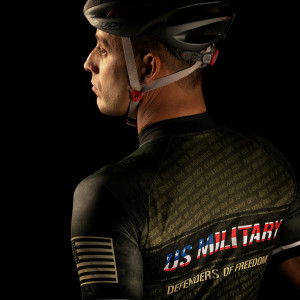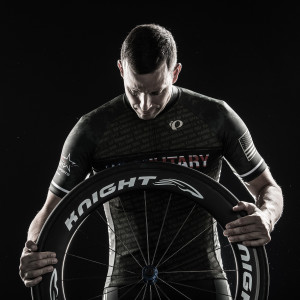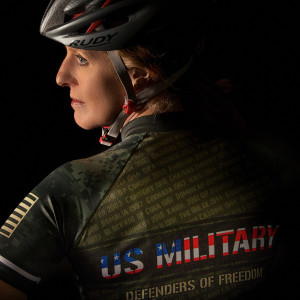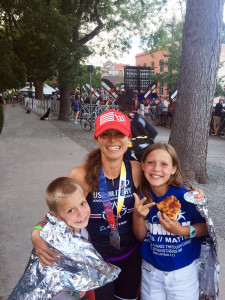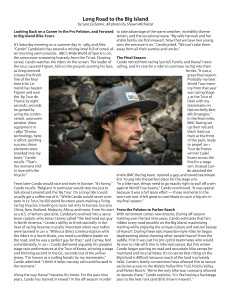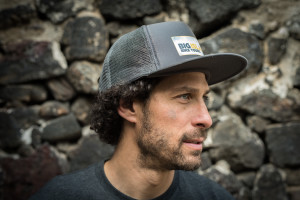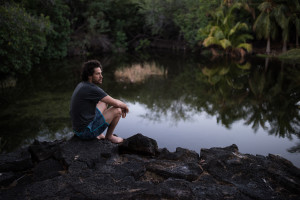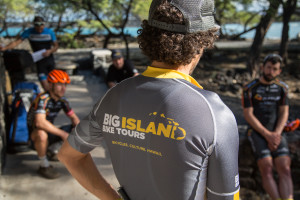photo credit Weldon Weaver
MIKE MOULY
“Waiting for something to happen or someone to tell you what to do is an easy habit to acquire,” says Mike Mouly. “In transitioning to civilian life, the mantra should be ‘Hurry up and do something.’” Mike’s advice comes from personal experience. After leaving the Marine Corps, Mike took care of the necessities of life, but didn’t develop any outside interests to replace the camaraderie and shared goals he had found in the military. He ballooned to 245 lbs., was smoking and drinking heavily, and ruptured two discs. It took a series of wake up calls for Mike to get back on the bike, and a whole series of major lifestyle changes for him to become an elite cyclist—again.
Mike had been an elite junior, winning his first kids’ triathlon at age 13 and his first bicycle race at age 14. Racing all through high school, Mike won the elite state championships in the Team Pursuit and Scratch Race, came in 3rd in the Junior Omnium at the Olympic Festival in Colorado Springs, and was a Cat 3 by age 17.
Reclaiming his original cycling potential was a difficult 10-year journey, comprising moves, coaches, MCL surgery and a protracted battle to quit cigarettes and watch his diet. Explaining his other mantra, “Sweat wipes off easier than regret,” Mike says, “doing all the work needed to attain a goal is just as good as reaching that goal.”
All that sweat paid off and in 2017 Mike finally became the regionally dominant, nationally competitive cyclist he had within himself. Despite a serious crash two weeks prior to nationals, Mike achieved 5th place in two events, the 40-44 scratch race and the 40-44 points race. He also placed 2nd at the NC/SC regional championships (40+), and was 1st place overall in the masters (winning the tempo race and elimination race) at the Omnium pro series at Dick Lane Velodrome. Now a Cat 2 on the track, in 2018 Mike looks forward to finally achieving his Cat 2 upgrade on the road.
Mike has found his flow again: “cycling takes a lot of repetition, training, and practice,” explains Mike. “When I’m on the bike, no matter what is going on in the rest of my life, at that moment everything is alright. Riding helped me focus on things that matter, not just in cycling, but at work and life.”
photo credit Weldon Weaver
MANDY MIDGETT
“My first deployment was to northern Iraq, near Mosul, to a place called Q-West. We were across from the bunker where all the ballots were kept from the first election,” remembers Mandy Midgett, USMES director of sport operations. “It was both an amazing and frightening time. Amazing because it was the first time in more than three decades the Iraqi people had ever had the opportunity to vote for their first democratically elected government. Frightening because there were still so many insurgents in the country against people having democracy. Polling stations were on high alert since the insurgents were targeting them with suicide bombs and mortar attacks.”
“During one of my last trips to Iraq, I was in Baghdad,” Mandy said. “When we were downrange we all ate clean, determined to come back fitter than when we left. I’m trying to stay on the downrange trim-down plan, but I know the dining facility has these amazing ice cream bars dipped in chocolate. One day we had incoming, a mortar landed right outside our office door. And I thought ‘WOW! That was a little too close, I guess I’ll eat ice cream tonight.’ Because you have to have perspective.”
Mandy retired from the Air Force in 2013 from the Joint Special Operations Command where she served on staff as a logistics planner, meaning she would plan and conduct special operations exercises and training, with special operations units. Mandy became passionate about triathlon in 1995 while serving in Panama and was selected to compete on the Air Force triathlon team for two years. During her seven deployments she worked hard to stay in racing shape, apart from the occasional mortar-induced ice cream.
Since she joined USMES, Mandy has filled several roles in the organization, including Camp Director and Triathlon Club Manager. “When I was preparing for our team camp this year, a senior staff member asked what my biggest worry was. I was kind of taken aback. I stated, ‘I guess someone going off the road and landing in the Saguaro cacti- now that would be just awful!’ But – no IEDs in the road, and everyone wants to be here. We stay in the Double Tree Hilton, and they serve us fresh chocolate chip cookies any time we ask for them.”
The USMES Triathlon Club had a stellar 2017, the best on record for the club, and arguably the best for a military triathlon club, ever. “We won the men and women’s military division at the Kona IRONMAN World Championships. At IRONMAN SUPERFROG we won the men’s overall for the second consecutive year, and won the overall team prize in our division for the second year in a row [SUPERFROG is the first and longest running half Ironman, started by Navy SEALs in 1979].” Some would see organizing a house full of endurance athletes as a daunting task; 20 USMESers competed at SUPERFROG. “I guess I’m good at calming people down, sharing my perspective, Mandy says. That’s an understanding largely shared by the members of USMES, who may have become somewhat desensitized to the idea of personal limits, but also understand what is – and isn’t at stake. “I think of our team as being the fun corner of endurance sports. Seriously, come hang out with us. We are all about the camaraderie, and we truly love riding, triathlon and running.”
Mandy had earned a BS in Social Psychology and a Master’s Degree in Organizational Management, and after retiring, she decided to pursue her life passion of coaching and mentoring triathletes and earned her certification as a USA Triathlon certified coach. “My military service was an amazing experience and it was a privilege that I got to be a part of something much bigger than myself. There are friends and perspective I wouldn’t give up for the world,” said Mandy. “And now I get to be part of USMES, and serve the athletes in this organization.”
But maybe no more camping. “Y’all can camp at Sea Otter,” Mandy stated. “I’ll be in Monterey, at the USMES team AirBnB. I don’t need to spend any more time in a flooded tent.”
This article was originally shared on the USMES Facebook page, and the Rudy Project Blog. It was also promoted by Knight Composites and Essentia.
